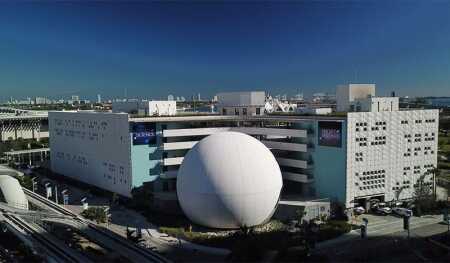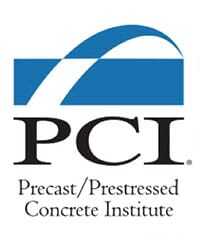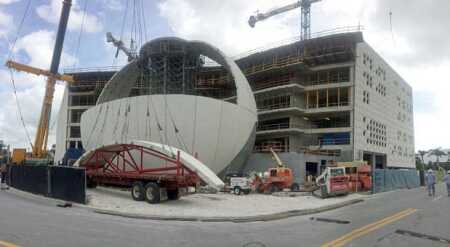This article was produced by the Precast/Prestressed Concrete Institute.
The 2018 winner of the Harry H. Edwards Industry Advancement Award, presented by the Precast/Prestressed Concrete Institute, proves that precast concrete can be used to deliver even the most complicated design ideas in a high-performance, cost-effective package. Designers of the Phillip and Patricia Frost Museum of Science in Miami wanted to create a structure that would surprise and delight patrons before they even walk through the door.
Their solution was to create a three-dimensional facade and construct a massive, dome-shaped planetarium with cutting-edge acoustics and a surface so smooth it can be used as a movie screen.
The six-story museum features open-air parking under five stories of museum comprising 250,000 square feet of interior and exterior space. The most prominent element of the design is the freestanding 67-foot-diameter dome, which houses the planetarium theater. While designers had not initially considered precast concrete for any part of the project, their early research determined it was the most flexible and durable solution, particularly for the dome.
“After looking at a steel structure to support cladding panels of different materials and considering a shotcrete dome, self-supporting spherical precast concrete structural panels proved to be the most cost-effective solution,” says James Palma, senior project manager at Rodriguez and Quiroga Architects. “It provided the density required for acoustics, the durable structure, and a light sandblast finish that was the perfect projection surface.”
Precast Solution
Once other cladding options were abandoned, the designers worked closely with Gate Precast Company to develop the concept using precast concrete as cladding and as the dome’s structure. The use of three-dimensional modeling was vital to ensuring that every piece fit perfectly and to addressing any errors in design before construction began, Palma says.
The dome cap, dubbed the Arctic Circle, was formed from two cap pieces combined to make a 30-foot-diameter keystone. The fabrication and quality assurance teams used a laser total station for layout and verification to achieve the perfectly round design. The cap was then made by placing concrete successively around the outer perimeter of the mold once the backform was in place. Each cap piece required 17 yards of architectural concrete.
The dome panels were cast exterior face down, with a top interior face form to address the significant curvature.
Each panel has a continuous ledge at the bottom to allow it to be set on the cast-in-place foundation wall, which was also curved to match the dome curvature. To eliminate cracking during any of the stages of production and construction, mono-strand post-tensioning anchored at the top and bottom of the panel was used.
To avoid damage in shipping and erection, job-site conditions were mimicked at the plant, including lifting pieces off the truck, and tilting and hanging them from a crane. Due to the requirement that no embeds were allowed for handling on the exterior face, steel-rope cables were attached to the underside of the pieces and wrapped on the sides. This innovative solution allowed the lifting device to fit in the gap between peel panels and then to be removed after all the panels were installed.
Once on the job site, the precast concrete cap was installed first, supported by a temporary custom shoring tower, then the spherical sections were installed and welded together “once the scaffolding was removed, making the dome completely self-supporting,” Palma says.
Along with the dome, patrons also love the unique geometric three-dimensional relief pattern on the facade of the north and west buildings. Gate created the design by combining 16 different geodesic shapes in various configurations on 95 panels. “The random patterning meant that almost no two panels are the same,” Palma says.
The Phillip and Patricia Frost Museum of Science is now among the world’s most innovative and sustainable science museums. “Miami has a rich history of using precast concrete in its civic architecture,” Palma says. “This design adds the most unique use of precast to this rich collection.”
More information about precast concrete can be found at www.PCI.org.
PROJECT TEAMOwnerThe Phillip and Patricia Frost Museum of Science, Miami, Florida
Precast Concrete ProducerGate Precast Company, Kissimmee, FloridaPrecast Concrete Specialty EngineereConstruct, Omaha, Nebraska
ArchitectRodriguez and Quiroga Architects Chartered, Coral Gables, FloridaExecutive ArchitectGrimshaw Architects, New York, New York
Awards2018 PCI Design Awards Harry H. Edwards Industry Advancement Award2018 PCI Design Awards Best Government and Public BuildingStructural Engineer of RecordDonnell Duquesne & Albaisa, Miami, FloridaMechanical, Electrical, and Plumbing EngineersFraga Engineers, Coral Gables, Florida
ContractorSkanska, Fort Lauderdale, FloridaPCI-Certified ErectorSpecialty Concrete Services Inc., Umatilla, Florida
KEY PROJECT ATTRIBUTES
• Precast concrete was used to create a massive, free-standing dome, 67 ft in diameter.• The dome cap mold had no square edges, requiring fabrication and quality assurance teams to use a laser total station for layout and verification.• The three-dimensional façade features 16 different geodesic shapes combined in various configurations to reflect elements from nature.
PROJECT/PRECAST SCOPE
• Precast concrete components include cladding panels for the museum’s north and west buildings, and dome segments connected by two precast concrete cap pieces to complete a full-sphere planetarium.• The dome features a sandblasted finish suitable for projection.• The project was submitted for LEED gold certification and museum operators plan to share data on its sustainability with visitors.• Project size: 250,000 ft²








